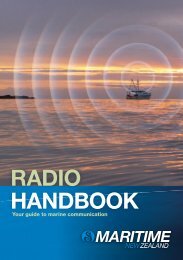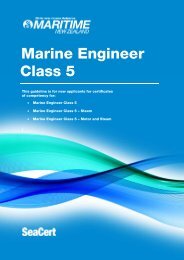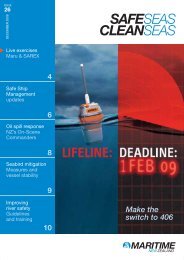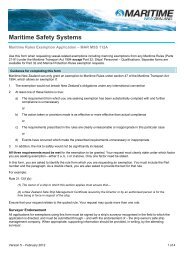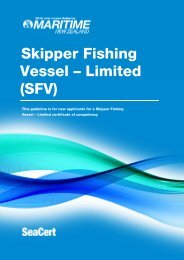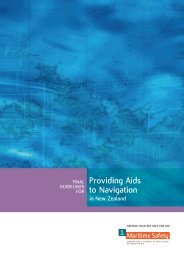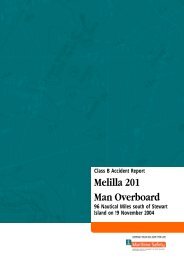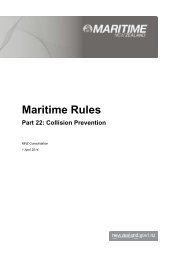You also want an ePaper? Increase the reach of your titles
YUMPU automatically turns print PDFs into web optimized ePapers that Google loves.
Inadequatefuel tankmountingcauses fireabove: Aft section of engine room bay.right: The vessel.A skipper died after hisfibre-glass launch collidedwith a passenger ferry at night.Visibility was poor with low overcastcloud and rain at the time of the accident.As the two vessels approached eachother in a nearly head-on situation, aseries of misunderstandings on bothvessels developed.The ferry master, who first observedthe launch ahead at a significantdistance, saw her red sidelight, andoccasionally both her green and redsidelights but felt the launch would passclear down the ferry’s port side. However,upon realising the launch was going to1. The Collision Rules make it clear thatin a head-on or nearly head-on situation,each vessel must alter course tostarboard so that each shall pass on theport side of the other. This tragedy wouldhave been avoided if the launch skipperhad stuck to this most basic requirement.The local bylaws also required the launchskipper to keep out of the way of the ferry.2. The launch skipper should have usedpass too close to his vessel, the mastersounded five short and rapid warningblasts on the ship’s whistle, and alteredcourse slightly to starboard.The launch skipper, navigating by eye,mistakenly believed the ferry had turnedto port towards the launch. Suddenlyrealising the danger, and about one minutefrom impact, the skipper turned to portto try and avoid the ferry. Tragically, thiscourse put him directly in the ferry’s path.Upon seeing the launch’s alteration ofcourse to port the ferry master put bothmain engines full astern and the rudderhard to starboard, sounding the ship’swhistle continuously.When the two vessels collided, theevery available tool to assist with hislookout. Navigating by eye at night is notoriouslyinaccurate. Although not fitted,radar would have assisted the skipper tomonitor his position in relation to knownferry tracks. The launch was fitted witha GPS plotter, however it did not haveelectronic charts for the accident area.3. Fibreglass is a poor radar reflector.Such vessels transiting areas that areWhen the twovessels collided, thelaunch capsized andwas cut in two by thebow of the ferry.Head On?Turn to starboard!launch capsized and was cut in two bythe bow of the ferry.The crewmember who was on thelaunch at the time of the collision wasable to swim out of the fore end windowof the upturned and flooded cabin. Shewas rescued by a lifeboat deployedfrom the ferry. The skipper’s body wasrecovered about 40 minutes later.The ferry was eventually stopped justshort of the land that had been on itsstarboard side before the collision.View the full report online at:www.maritimenz.govt.nzLookout!Pointsfrequently used by large vessels wouldincrease their visibility by fitting passiveradar reflectors.4. Although recreational vessels are notrequired to carry VHF radio. This wouldhave proven a simple and effective wayfor the ferry master to establish communicationswith the launch and to resolvethe developing problem.An incorrectly installed fueltank caused a fire thatseriously damaged a 9.5 metrealuminium rescue vessel.The skipper and four crew wereresponding at speed to an incident whenthey smelled diesel. Looking astern, theysaw oil on the water and thick smokecoming from the engine bay vents. Theydecided, rightly, not to open the cover boxto the engine bay, to prevent more oxygenfeeding the fire. Attempts to control thefire by shutting off the fuel supply werethwarted by the presence of thick smoke.After issuing a Mayday call on channel16 and advising <strong>Maritime</strong> NZ’s <strong>Maritime</strong>Operations Centre of the situation, theskipper ordered the crew to abandon the1. The failure to comply with design andconstruction specifications was due tothe tight fit of the fuel tank in the well.This meant that there was inadequateroom to allow for the specified mountingsystem to be utilised and as a result analternate system was installed.2. The vessel was fitted with anautomatic bilge alarm that was audibleat the steering position on the vessel.However, the crew did not hear the alarmsound. The skipper believed this couldhave been due to the float switch beinglocated in the forward section of theengine bay bilge and not activating, asthe vessel was on the plane and trimmedby the stern with the spilled fuel accumulatingin the aft section of the bilge.3. There is no requirement under<strong>Maritime</strong> Rules for vessels of this size tobe fitted with a fixed fire fighting systemin the machinery space. The crew werevessel to avoid further exposure to thetoxic smoke. Two recreational vesselsthat had responded to the vessel’sMayday subsequently rescued the crewfrom the water.An hour later, the fire was extinguishedby the Fire Service and otherrescue vessels, and the fire damagedvessel was towed back to port and liftedout of the water.On inspection, it was found that thewelding of the four aluminium anglebrackets – measuring 6mm in thicknessand 47mm in width – that were designedto hold the 450 litre diesel fuel tank firmlyin position to the hull, was substandardwith inadequate penetration and fusion.Moreover, the fuel tank was securedcontrary to design and constructionThe spilled diesel was then sprayedover the hot turbo charger of the engineunable to direct the vessel’s portablefire extinguishers onto the fire due to theextent of the thick acrid smoke.4. Different fire fighting systems areavailable to small vessel operators thatcan be installed in engine bays to providea flood type system. These include:■ FM 200 systems that operate by cableor automatic sprinkler systems thatrespond to high temperature levelsCO 2 systems with self latching handlesattached to copper or steel tubing thatlead into an engine space. Powder extinguisherswith swage lock connectionsthrough bulkheads or engine box coversthat enable the nozzle of an extinguisherto lock into a quick release connector.■ <strong>Maritime</strong> <strong>New</strong> <strong>Zealand</strong> has been askedto give consideration to a Rule amendmentrequiring vessels of less than 15metres in length to be installed witha fixed fire fighting system or one ofspecifications. As a result, the fuel tankhad moved by about 50mm from itsoriginal welded position whilst the vesselwas operating at speed. This shift in theposition of the fuel tank caused the fuelfiller line to disconnect which resulted inabout 250 litres of diesel spilling into thebilge of the engine bay.The spilled diesel was then sprayedover the hot turbo charger of the engineby the action of the turning propellershaft, resulting in ignition and fire.The vessel was substantially damagedbut was able to return to serviceonce a new engine had been installedand repairs carried out.View the full report online at:www.maritimenz.govt.nzLookout!Pointsthe above systems, or the carriage ofa remote (from the machinery space)power driven emergency fire pump.5. Fuel that is sprayed onto the hotspots of an engine by a rotating propellershaft, including a turbo charger, is of adensity that is particularly susceptible toignition. Many fires on smaller vesselshave been caused in this manner andare often exacerbated by the difficultiesin accessing the fire directly due to thepresence of smoke, heat, toxic fumesand limited physical access.6. It is essential that fuel tanks areadequately secured as loose or rupturedfuel tanks pose a serious threat to thesafety of a vessel and its crew. In highspeed vessels, such as in this case, thehydraulic pressure created by free surfaceeffects in fuel tanks, even when they arebaffled, can exert considerable force onsystems used to secure such tanks.18 LOOKOUT! JULY <strong>2006</strong>LOOKOUT! JULY <strong>2006</strong> 19





